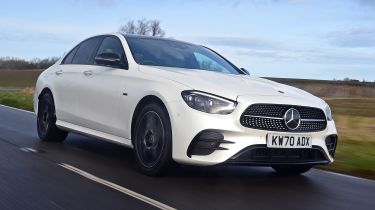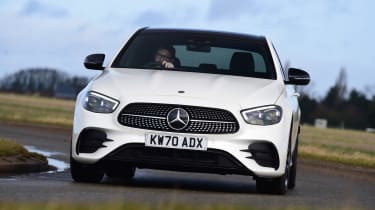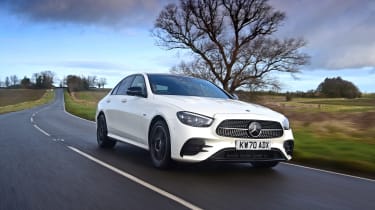Mercedes E-Class (2016-2023) - Engines, performance and drive
Improved efficiency and refinement is where Mercedes has made big strides with the E-Class

Just so you know, this is an older review of the 2016-2023 Mercedes E-Class. If you are interested in information about how the new Mercedes E-Class drives, or news about the latest Mercedes models, please follow the links provided.
It's not the sharpest large saloon on sale, but the E-Class delivers when it comes to comfort and refinement. Steel springs with adaptive dampers are standard in the UK, while fully adaptive air-suspension is an option.
The standard coil springs and adaptive damper suspension set-up does a better job of soaking up bumps than the firmer Jaguar XF, but trails the BMW 5 Series for ultimate comfort. While it deals with big bumps well, broken tarmac and potholes send the occasional shake and shudder through the floor of the cabin. Cars with optional air-suspension ride serenely, offering lots of composure, plenty of comfort and good body control. While the car floats along nicely on faster, smoother roads, go for an AMG Line model, and the larger wheels mean the ride will feel a little unsettled on more jagged surfaces.
There are different driving modes to sharpen up the steering, throttle response and damping, but it’s best to leave the E-Class in Comfort and make the most of its cosseting, refined ride. Hit a corner quickly, and you’ll find body control soft in Comfort mode. Sport or Sport+ settings reduce roll, but also add an artificial weight to the lifeless steering. It’s not as agile as the sportier XF, but you can’t fault its grip and composure.
Used - available now

2020 Mercedes
E Class
16,426 milesAutomaticDiesel2.0L
Cash £30,587
2022 Mercedes
E Class
46,558 milesAutomaticPetrol2.0L
Cash £26,763
2020 Mercedes
E Class
35,726 milesAutomaticDiesel2.0L
Cash £26,187
2023 Mercedes
E Class
60,859 milesAutomaticDiesel2.0L
Cash £28,995The impressive ride stems from the E-Class’ weight loss plan, having shed “around 100kg” over its predecessor depending on spec, according to Mercedes. Aluminium body panels have helped here, meaning the E-Class delivers a fluid ride even over poor road surfaces.
Combined with the impressive levels of refinement from the engines and the standard nine-speed automatic gearbox, which slurs changes nicely and responds sharply enough to pulls on the steering wheel mounted paddles, it’s easy to make relaxed progress.
Whereas the BMW 5 Series and Jaguar XF offer more for keen drivers, the E-Class puts the focus more on comfort and quality, delivering a relaxed drive at the expense of some handling performance that, for most people day-to-day, will be a welcome benefit.
You can still drive it hard and lean on the decent amount of grip available, but it doesn’t feel quite as natural as in some larger saloons. There’s always a reassuring, planted feel on the road though, while Mercedes’ clever safety systems – including the E-Class’ standard autonomous braking – offer peace of mind.
0-62mph acceleration and top speed
Mercedes’ 2.0-litre four-cylinder turbodiesel opens the E-Class range in the E 220 d. With 191bhp and 400Nm of torque on offer in the latter, this is now faster than the old E 250 d, but importantly the new 2.0-litre unit is much quieter than the clattery old 2.1-litre diesel.
The 0-62mph sprint takes 7.3 seconds, while top speed stands at 149mph, but it’s the smooth, subdued pulling performance that impresses most. Refinement is much improved, and the new four-cylinder diesel is easily a match for the 2.0-litre Ingenium unit in the Jaguar XF when it comes to a subdued idle and quiet cruising on the motorway. The nine-speed auto gearbox makes for low cruising revs of just 1,300rpm at 70mph, and the car's slippery shape also means there’s virtually no wind noise.
If you want extra performance, the E 400 d 4MATIC certainly offers that. With its 3.0-litre turbo diesel straight-six there’s a mammoth 700Nm on tap. This, combined with 335bhp, gives a seriously quick 4.9 second 0-62mph sprint. However, it’s how the E 400 d pulls from low revs with plenty of potency that demands your attention.
Squeeze the throttle and the engine pulls hard from as low as 1,200rpm. Also, it will happily plod along at 30mph in sixth gear and accelerate all the way up to motorway speeds with minimal fuss. There’s no real need to wring the engine out past 3,000rpm because of the effortless power delivery. Add in the supple ride quality and the E 400 d is simply one of the most relaxing and refined cars in which to cover long distances.
But, if you'd rather not have an oil-burner, then the capable E 450 4MATIC could be the answer - powered by a 3.0-litre six-cylinder petrol engine, it produces 362bhp and 500Nm of torque and reaches 0-62mph in 5.1 seconds.
The 429bhp AMG E 53 acts as a go-between for the standard E-Class models and the fire-breathing AMG E 63 S. It combines straight-six power with 48v mild-hybrid technology to help optimise performance. There’s plenty of grunt to be exploited in the mid-range, thanks to the 520Nm torque output. Acceleration is decent too, taking only 4.5 seconds to get from 0-62mph.
The top-of-the-line engine is the E 63 S, with a massive 4.0-litre V8 giving 604bhp. Performance is a step above the E 53, tackling the 0-62mph sprint in 3.4 seconds and pressing on, if you go for the optional £765 AMG Driver’s Package, to a top speed of 186mph.
It’ll be the E 220 d that makes up the majority of sales in the UK. However, Mercedes’ frugal E 300 e and E 300 de plug-in hybrids aim to be successful in the business market.
Combining a turbocharged 2.0-litre four-cylinder petrol or diesel engine with an electric motor, the cars offer brisk performance, with both producing over 300bhp and 700Nm of torque. The two hybrids will cover 0-62mph in less than six seconds and press on to top speeds in excess of 155mph.
On the road, the E 300 e shows how far electrification has come. If you’re careful, (and if you follow the car’s suggested economical route) you should be able to squeeze more than 30 miles of pure-electric driving, which is enough for most morning commutes. The car feels a little less keen to change direction thanks to the extra weight of its batteries, but the plug-in hybrid is still good to drive and very comfortable.
More reviews
Car group tests
In-depth reviews
Road tests
Used car tests
Which Is Best
Fastest
- NameE450d 4M AMG Line Premium 4dr 9G-Tronic [Pan Roof]
- Gearbox typeSemi-auto
- RRP£79,870












